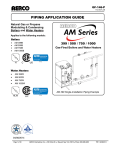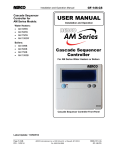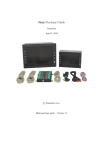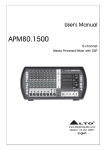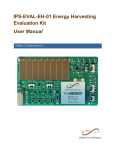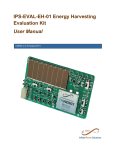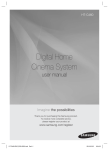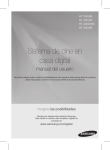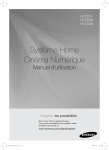Download innos i7, MN8 Wingtip User Manual
Transcript
Mobile Phone innos i7, MN8 Wingtip User Manual Dear Customer, Thank you for purchasing innosi7 Full Touch Screen Mobile Phone. Kindly read this user manual carefully to learn about key functional characteristics and operational methods of this mobile phone. innos i7 is a smart phone based on Android open operating system. With applications pre-installed and others that you can download from internet such as google play store which will take you to an excellent experience of communication and entertainment. The phone supports Qualcomm® Snapdragon™ Audio+ function which enhances the voice quality to a great extent. It can bring an excellent audio experience while listening music and watching film. 2 Contents 1. POINTS OF ATTENTION ON SAFETY ............ 5 1.1 SAFETY ALERT AND CAUTIONS ............................... 5 1.2 PROTECTING YOUR BATTERY ................................ 5 1.3 CLEANING AND MAINTENANCE ............................... 7 2. GETTING STARTED ......................................... 8 2.1 PHONE OVERVIEW ............................................... 8 2.2 OPEN THE BATTERY DOOR..................................... 9 2.3 INSTALL SIM CARD .............................................. 9 2.4 INSTALL MEMORY CARD........................................ 9 2.5 POWER ON/OFF ................................................. 10 2.6 BATTERY CHARGING .......................................... 10 2.7 SECURITY ......................................................... 10 3. BASIC OPERATION & KNOWLEDGE ........... 12 3.1 USING TOUCH SCREEN....................................... 12 3.2 USING KEYS ...................................................... 12 3.3 HOME & MAIN MENU SCREEN .............................. 13 3.4 SCREEN LOCK & DISPLAY OFF............................. 13 3.5 USING THE ON SCREEN KEYBOARD...................... 13 3.6 STATUS BAR ...................................................... 13 3.7 USING SENSORS ................................................ 14 3.8 CONNECTIVITY................................................... 15 3.9 STORAGE .......................................................... 15 3.10 CONTACT .......................................................... 16 3.11 CALL ................................................................ 16 3.12 MESSAGING ...................................................... 17 3.13 MULTIMEDIA ...................................................... 17 3.14 APPLICATIONS ................................................... 17 3.15 GPS ................................................................ 18 3 1.1 1. Points of attention on safety Safety Alert and Cautions IMPORTANT! Please read these instructions carefully and follow them implicitly in case of any dangerous or illicit situations. Note driving safety It is strongly recommended that you do not use a mobile phone when driving. Please use the personal hand free package when a call is inevitable. Please put your mobile phone in the mobile phone holder safely, and don’t put it at a passenger’s seat or any other place that may risk a drop of your mobile phone in the case of collision or emergency brake. Switch off your mobile phone on the airplane Interference caused by mobile phones affects aviation safety, and thus it is illegal to use it on the airplane. Please make sure your mobile phone is switched off when you are on a plane. Switch off your mobile phone in blasting operation area You should strictly obey relevant laws and regulations and switch off your mobile phone in or near blasting operation area. Switch off your mobile phone near dangerous area Your cell phone is not allowed to switch on when the refueling and chemical substance area is nearby. In a hospital When using it in a hospital, you should be subject to the relevant rules specified by the hospital. Make sure your mobile phone is switched off when medical equipment is nearby. Any wireless transmission equipment, mobile phones included, will affect its performance. Other electronic equipment may be affected as well. If you have any question in this regard, please consult relevant doctor or equipment supplier directly. Interference 4 Any interference caused by wireless equipment can do damage to its performance. Qualified services Only qualified services are allowed to install or repair mobile phones. If you install or repair it by yourself, you may break the guarantee rules. Accessories and batteries Only manufacturer recognized accessories and batteries can be used. Reasonable use It should be used normally. It is absolutely forbidden to put it on the condition that with an extremely high temperature (over 60 Celsius degrees), for example, do not put it under the window where it can be exposed to the sunshine directly. Remember to use wet or antistatic cloth, instead of using any cloth with static electricity to clean it. Emergency call Make sure your mobile phone is powered on and is in the service, if you would like to make an emergency call number such as 911, pressing the dial key and confirm your location, simply explain what has happened, and don’t terminate the call without any permission. Note: Like any mobile phone, it may not be supported due to the network coverage and wireless signal transmission. What’s more, some networks even don’t support the 112 emergency call services. Therefore, the communication under emergent situations (such as first aid) should not be completely depended on mobile phones. You can consult and check with you local network suppliers. Notes: ·All screen shots in this guide are simulated, Actual displays may vary. ·Instructions to perform tasks in this guide may change depending on the software version on your phone. ·Unless specified otherwise, all instructions to perform tasks in this guide assume that you are starting from the home screen. 1.2 Protecting Your Battery Warn reminders about battery: Please don’t store your mobile phone battery at an extremely high or low temperature, for it will affect the service life of the battery, and shorten the standby time. The service life of the mobile phone 5 battery is subject to a certain limit. It is recommended that you would better change a battery from the original supplier if the performance of the battery has declined after using it for a period of time. Points of attention on use of battery: Be sure to switch off the mobile phone before you remove the battery. Please use it carefully. A short circuit will occur if the positive pole (+) and the negative pole (-) of the battery is connected with a metal object (for example, a coin or clip), it may do damage to both the battery and the metal object. Make sure that no metal object will be connected simultaneously with the positive pole and the negative pole of the battery after it is removed and put in a bag. Don’t throw the battery into the fire, or use it under an extremely high temperature condition. Don’t dismantle or modify the battery. Don’t put battery in an occasion with strong mechanical impact, or use a hard object to penetrate the battery. Battery should be put in a cool and dry place to avoid direct sunlight. It should not be placed with a high temperature (over 60 Celsius degrees) environment. If battery gives out any peculiar smell or getting overheated, you should stop using it. If the battery is found to have any crack, deformation, damage of other type, or electrolyte leakage, it should be stopped using immediately. Please clean your skin or clothes immediately with soap and clear water if they contact leaking electrolyte, and wash your eyes completely with clear water if any electrolyte splashes into. In case of any injury caused by incorrect charge, only original battery is allowed to be charged. Don’t use the li-polymer battery when the temperature is extremely low, for the maximum standby/call time is not available at a low temperature. Don’t clean the battery with water or organic solvent, or immerse the battery in water. Make sure the battery is fully charged if it has been out of use 6 for a long period. 1.3 It is recommended that the rejected battery be returned to the mobile phone manufacturer or placed in a designated public area for rejected battery recycling. Don’t mix it with other garbage or throw it freely. Cleaning and Maintenance Please don’t leave the phone, the battery and the charger in the bathroom and other high humidity places, and prevent them from rain. Please clean the phone, the battery and the charger using soft and dry cloth. Please don’t wipe the phone using alcohol, thinner or benzene and other chemical reagents. The socket with dirt may cause poor contact and power-off. Please clean it regularly. 7 2. Getting Started 2.1 Phone Overview 8 2.2 Open the battery cover Push the battery cover upwards. 2.3 Install SIM Card This phone supports single SIM/USIM cards, before you power on the phone, make sure there is at least one SIM/USIM card is inserted in either USIM/SIM card slot. 9 2.4 Install Memory Card Aim at the T-Flash card slot and push the T-Flash card gently, and the card will be inserted correctly. Note: If the memory card is failed, please check whether it is correctly placed at good contact of metal point. 2.5 Power on/off In power off status, press and hold the power key on right side for about 2 seconds to power on your phone. In power on status, press and hold the power key for about 2 seconds to power off your phone. 2.6 Battery Charging You can charge the battery by connecting the phone either to a pc USB port or to the provided standard charger use the provided standard usb cable. Note: In order to ensure normal operation of the phone, please make sure to use the designated charger. 2.7 Security A series of passwords have been set in your mobile phone and SIM card, for they can prevent any unauthorized use of your mobile phone and SIM card. The Pin Code of the Sim Card: The PIN code (personal identification number, 4~8 digits) is used to prevent unauthorized use of your SIM card. If the PIN verification function is activated, the PIN code will be required to start the mobile phone each time. If you have entered the PIN code incorrectly for three times, the SIM card will be locked. The following instructions indicate you how to unlock the card: 1> Enter the correct PUK code in line with the prompt on the 10 screen to unlock the SIM card. 2> Then enter a new PIN code and tap the Enter key. 3> When you are prompted to reenter the new PIN code, reenter the new PIN code and tap the Enter key. 4> If the PUK code is correct, the SIM card will be unlocked, and the PIN code is reset. Warning: If you have entered the PIN code incorrectly for three times, the SIM card will be locked automatically, in that case you need to use the PUK code to unlock the card. The PUK code is generally kept by the network operator. PUK code: The PUK code (the PIN unlocking password, 8 digits) is used to unlock the locked PIN code. The PUK code is provided by the manufacturer together with the SIM card. If you have entered the PUK code incorrectly for ten times, the SIM card will be invalidated. You need to ask your network supplier for a new card. PIN2 code: The PIN2 code (4~8 digits) is provided together with the SIM card, which is used to set the fixed dial and other functions. Please contact your network operator to check if your SIM card supports such functions. If you have entered the PIN2 code incorrectly for three times, the PIN2 code will be locked. The PIN2 code will be unlocked only by entering the correct PUK2 code. The operations are as follows: 1> Enter the correct PUK2 code in line with the prompt on the screen to unlock the PIN2 code. 2> Then enter a new PIN2 code and tap the Enter key. 3> When you are prompted to reenter the new PIN2 code, reenter the new PIN2 code and tap the Enter key. PUK2 code: The PUK2 code (the PIN2 unlocking password, 8 digits) is used to unlock the locked PIN2 code. The PUK2 code is provided by the manufacturer together with the SIM card. If the PUK2 code has not been provided, please contact your network operator. If you have entered the PUK2 code incorrectly for ten times, you will be unable to use the functions of the PUK2 code. If you want to use these functions, please contact your network operator to change a new card. 11 3. 3.1 Basic operation & knowledge Using Touch Screen Tap To act on items on the screen, such as application, settings icons and options, to type letters and symbols using the onscreen keyboard, or to press onscreen buttons, you simply touch down your finger on them and then lift your finger without change the touch down position in a short time. Tap & hold Touch down your finger on the screen without lifting up or moving for about 2 seconds. This action will pop-up an special options list or active some special actions. Drag Touch down your finger on screen and move without lifting up to scroll options, switch screens and other contents displayed on screen. Flick Drag quickly and release, To scroll through a list or move quickly, flick across the touch screen, When you flick a long list, tap the screen to stop it from scrolling. Pinch In some applications (such as Maps, Browser, and Gallery), you can zoom in and out by placing two fingers on the screen at once and pinching them together (to zoom out) or spreading them apart (to zoom in). 3.2 Using Keys Power key: Press and hold Power key to open the power key menu, where you can power off, restart, set airplane mode, switch silent mode, vibration mode and standard mode. Volume key: Press the volume keys to change the ring volume (on the home screen) or the earpiece volume (during a call). Press the volume button will cancel ringtones when incoming calls. Menu key: Opens a menu with items that affect the current screen or application. When you want to exit from an application or do other operations, if there is no option button displayed on screen, try this menu key. Home key: Press Home to close any menu or app and return to the home screen. On the home screen, press and hold Home to show the last few apps you used, then tap an app to open it. Back key: Opens the previous screen you were working in. If the onscreen keyboard is open, closes the keyboard. 12 3.3 Home & Main menu screen When you sign in, the Home screen opens. It is your starting point to access all the features on your phone, displays application icons, widgets, shortcuts, and other features. You can customize the Home screen with different wallpaper and display the items you want. In Home screen, tap the menu button to enter the Main menu screen where displays all the apps have been installed in your phone. 3.4 Screen Lock & Display off You can customize the phone’s display off time in menu Settings -> Display -> Sleep. without any operation to the phone in the set time, the LCD display will go off, short press any of Power key will wake up the display from off mode. If you wake up the display in more than 5 seconds after the LCD auto go off, it will be in the screen lock position, there are 5 (Slide, Face Unlock, Pattern, PIN, Password) different ways to unlock the screen according to your settings under menu Settings -> Security ->Screen lock, by default None option is activated, with this option. 3.5 Using the on Screen Keyboard You enter text using the onscreen keyboard. Some applications open the keyboard automatically. In others, you touch a text field where you want to enter text to open the keyboard. If you have installed the third party input method application, before you apply this input method, you should firstly enable it under menu Settings -> Language & input. 3.6 Status bar The Status bar appears at the top of every screen. It displays icons indicating that you’ve received notifications (on the left), icons indicating the phone’s status (on the right), and programs run in background, along with the current time. 13 Status icons Received notification icons The applications you installed in your phone may use their own notification icons while running in background. To open the Notifications panel: Drag the Status bar down from the top of the screen. 3.7 Using sensors Proximity Sensor detects how close an object is to the surface of the screen. This is typically used to detect (and skip) accidental touchscreen taps when held to the ear during a call. (While talking on the phone, the sensor detects talk activity and locks the keypad to prevent accidental key presses). Light Sensor lets you use the ambient light level to adjust 14 the screen brightness/contrast. Gravity sensor detects your phone’s acceleration direction and takes responding actions according to the running application. Rotate the screen display when you rotate the device while using some features. To set the interface to keep the orientation when you rotate the device, select Settings -> Display -> Auto-rotate screen. Take actions according to the gravity’s real time orientation angle, typically used in games. Responding to your actions such swing the device in some applications. 3.8 Connectivity PC connections: You can connect your device to a PC using a USB data cable. When you connect the device to a PC, you can synchronize data with an Android synchronization tool running at PC side, which you can download from google play store, and transfer data to and from your device directly. You can connect your phone to a computer with a USB cable, to transfer music, pictures, and other files between your phone’s SD card and the computer. To use this feature, you should follow the 4 steps below: 1. Use the USB cable that came with your phone to connect the phone to a USB port on your computer (you will receive a notification that the USB is connected). 2. Open the Notifications panel and tap USB Connected. 3. Tap Turn on USB storage, then you can transfer files between PC and SD card. 3.9 Storage There are 2 kinds of user storage memory with your phone, phone built-in storage and SD card storage. The phone built-in storage is mainly used for installing application space (see install applications section) and other information data, user data can store in external MMC. Application programs and other data you downloaded from internet or transferred from other devices, camera captured 15 photos, recorded videos or recording are all stored in external MMC, some files to be accessed by applications such as music, images, videos etc. must be stored in SD card memory or external MMC, you can also make your application installed in SD card (see install applications section). 3.10 Contact Contacts gives you quick and easy access to the people you want to reach. When you first turn on your phone and sign into your Google Account, any existing Google contacts are downloaded to your phone. After that, your contacts are synchronized: any changes you make to your contacts on the phone or the web are made in both places, the next time you sync. Contacts from Exchange ActiveSync accounts are also synced in this way. Information about your contacts is shared with other applications, such as Gmail, Messaging, and so on. If you have more than one account with contact information, Contacts joins duplicates into a single entry. You can also manage that process manually 3.11 Call Make a call: Tap on dial button on Home screen or on menu screen to enter dial board screen, enter the phone number and tap send out button to make a call. In contact list, tap the contact and then tap on button after entering another screen. In other applications such as message, call log, there are also options for make a call. Answer/Reject a call: When you receive a phone call, drag to the right until it reaches the green dot to answer a call, drag to the left until it reaches the red dot to reject an incoming call. During a call conversation, press the side volume key to adjust volume, tap at bottom to open dial pad, tap open the loudspeaker, etc. 16 to 3.12 Messaging You can use Messaging to exchange text messages (SMS) and multimedia messages (MMS) with your friends on their mobile phones. You can send text (SMS) messages of up to 160 characters to another mobile phone. If you keep typing after the limit, your message will exchange to two message automatically. Multimedia (MMS) messages can contain text and a picture, a recorded voice, an audio file, a video, or a picture slideshow. Messaging automatically converts a message into a multimedia message if you send it to an email address instead of a phone number, add a subject, or attach a media file. Press on Main menu screen to access message. When new message received, the message notification icon will be shown on the notification bar, drag down the bar and tap on the message to read. 3.13 Multimedia Camera is a combination camera and camcorder that you use to shoot and share pictures and videos. Pictures and videos are stored on the phone’s SD card or phone. Gallery is used to view pictures and play videos that you’ve taken with Camera, downloaded, or copied onto your SD card or phone. You can perform basic editing tasks on pictures and set them as your wallpaper or contact picture. Music collects all audio files from your SD card or phone to play. Videos collects all video files from your SD card or phone to play. 3.14 Applications Based on the Android platform, your device’s functionality can be extended by installing additional applications, These applications can be downloaded from internet such as Android Market. Three ways to install applications in your phone: Directly down load from internet, when the downloading task is completed, select the application in your download list to install. Note: How to install may depend on the browser you use. Download applications to your PC local disk, and install 17 from PC by running phone suite. If have a file manager installed in you phone, you can transfer or download applications to your SD card, find out the application you want to install under path and tap on it. Note: To install applications downloaded from websites other than Android Market or Play Store, you must select Settings ->Security -> Unknown sources. Warning: Applications downloaded from internet can be from unknown sources. To protect your phone and personal data, download applications only from trusted sources such as Android Market. To manage applications: Enter Settings -> Apps -> ALL, you can access all the applications. Tap on an application under each tag list, it will enter the Application info screen, along with manage buttons. Force stop to close a running application, it is stopped without confirmation. Uninstall to uninstall applications that you don’t want to use any more, and free the storage space that they occupied. Clear data to delete user data about an application such as accounts, databases, settings and so on. Move to SD card/phone to move applications installed in phone/SD card to SD card/phone memory. Clear cache to delete temporary data for this application stored in phone. 3.15 GPS With the global positioning system (GPS) receiver in your phone, you can find your location within a accuracy about 50 meters. To use this facility, you should install applications to support, such as google map. 18 FCC Regulations: This mobile phone complies with part 15 of the FCC Rules. Operation is subject to the following two conditions: (1) This device may not cause harmful interference, and (2) this device must accept any interference received, including interference that may cause undesired operation. This mobile phone has been tested and found to comply with the limits for a Class B digital device, pursuant to Part 15 of the FCC Rules. These limits are designed to provide reasonable protection against harmful interference in a residential installation. This equipment generates, uses and can radiated radio frequency energy and, if not installed and used in accordance with the instructions, may cause harmful interference to radio communications. However, there is no guarantee that interference will not occur in a particular installation If this equipment does cause harmful interference to radio or television reception, which can be determined by turning the equipment off and on, the user is encouraged to try to correct the interference by one or more of the following measures: -Reorient or relocate the receiving antenna. -Increase the separation between the equipment and receiver. -Connect the equipment into an outlet on a circuit different from that to which the receiver is connected. -Consult the dealer or an experienced radio/TV technician for help. 19 Changes or modifications not expressly approved by the party responsible for compliance could void the user‘s authority to operate the equipment. RF Exposure Information (SAR) This model phone meets the government’s requirements for exposure to radio waves. This phone is designed and manufactured not to exceed the emission limits for exposure to radio frequency (RF) energy set by the Federal Communications Commission of the U.S. Government. The exposure standard for wireless mobile phones employs a unit of measurement known as the Specific Absorption Rate, or SAR. The SAR limit set by the FCC is 1.6 W/kg. *Tests for SAR are conducted using standard operating positions accepted by the FCC with the phone transmitting at its highest certified power level in all tested frequency bands. Although the SAR is determined at the highest certified power level, the actual SAR level of the phone while operating can be well below the maximum value. This is because the phone is designed to operate at multiple power levels so as to use only the poser required to reach the network. In general, the closer you are to a wireless base station antenna, the lower the power output. The highest SAR value for the model phone as reported to the FCC when tested for use at the ear is 0.399W/kg and when worn on the body, as described in this user guide, is 1.282W/kg (Body-worn measurements differ among phone models, depending upon available enhancements and FCC 20 requirements.) While there may be differences between the SAR levels of various phones and at various positions, they all meet the government requirement. The FCC has granted an Equipment Authorization for this model phone with all reported SAR levels evaluated as in compliance with the FCC RF exposure guidelines. SAR information on this model phone is on file with the FCC and can be found under the Display Grant section of http://www.fcc.gov/oet/fccid after searching on FCC ID: COYI7. For body worn operation, this phone has been tested and meets the FCC RF exposure guidelines for use with an accessory that contains no metal and the positions the handset a minimum of 1.0 cm from the body. Use of other enhancements may not ensure compliance with FCC RF exposure guidelines. If you do not use a body-worn accessory and are not holding the phone at the ear, position the handset a minimum of 1.0 cm from your body when the phone is switched on. 21





















